Hungry Ghost Festival
中元节, 盂兰盆
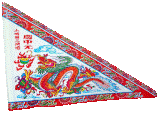 The Chinese believe that on the 7th lunar month of each year, spirits of the deceased return to the human realm for a month. The seventh month is sometimes referred to as the ghost month, 鬼月, and the festival is commonly known as the “hungry ghost festival”. The Chinese believe that on the 7th lunar month of each year, spirits of the deceased return to the human realm for a month. The seventh month is sometimes referred to as the ghost month, 鬼月, and the festival is commonly known as the “hungry ghost festival”.
Many people avoid important events during the 7th month. Activities to avoid include moving to new homes, weddings, and opening ceremony of new businesses.
Ullambana, Yulan Jie, 盂兰盆
The hungry ghost month is known to the Buddhist as the Ullambana, Yulan Jie, 盂兰盆. The background story told of the Maudgalyayana (Mu Lian), a disciple of the Buddha, who attempted to help his mother who was reborn into the realm of the hungry ghost. The Buddha instructed Maudgalyayana to perform acts of merit and to transfer the merits to his mother.
Following the Buddha’s advise, Maudgalyayana managed to transfer merit to his mother and to help her reborn into the human realm.
During Yulan Pen Jie, 盂兰盆, Buddhist offer prayers to deceased ancestors and wandering spirits to help them in their rebirth in higher realms. There are also prayer sessions in monasteries to pray and to dedicate merit to wandering spirits.
Zhong Yuan Jie, 中元节
The Hungry Ghost Festival is known to the Taoist as Zhong Yuan Jie, 中元节.
During this period, clan associations, temples, monasteries, businesses and families organize prayers and make food offerings and burn paper made clothes, daily necessities and luxury items to these spirits.
These paper items include credit card, clothes, cosmetic, XO cognac, beer, laptop, DVD players, mobile phones and larger items such as Mercedes, houses, planes, and ships.
Prayer events often end with a dinner for all participants and during the dinner, auctions are held to raise funds for charities. So while the rituals are meant for spirits visiting the human realm, the activities benefit the socially disadvantaged through charity auctions.
In Singapore and Malaysia, Zhong Yuan Jie includes a dinner for all participants complete with entertainment for both spirits and humans. In the past, it used to be Chinese operas but these days, the trend has shifted towards pop Chinese music on a makeshift stage known as Gei Tai 歌台.
In 1992, the Hungry Ghost festival rituals at the Kobe Kanteibyo (Guan Gong Temple) was designated as Kobe (Japan) City Community Folklore Intangible Cultural Asset.
In the port city of Keelong Taiwan, Hungry Ghost Festival is a major event and a tourist attraction. They even have probably the world's first and only museum dedicated to the festival; Keelung Mid Summer Ghost Festival Museum 基隆市中元祭祀文物馆
Although there are some differences in the rituals and beliefs of between Buddhist and Taoist, it is not uncommon for Chinese to participate in both forms of worship or rituals during this period.
Related pages:
|
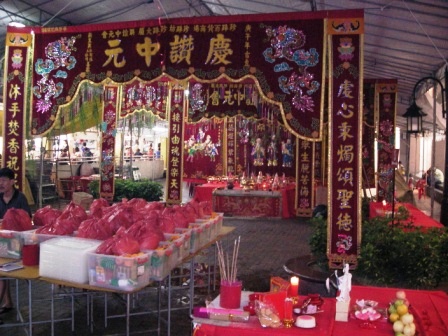
Taoist rituals during Zhong Yuan Jie

Buddhist Venerable chanting during the Hungry Ghost Festival at Thian Hock Keng Temple, Singapore
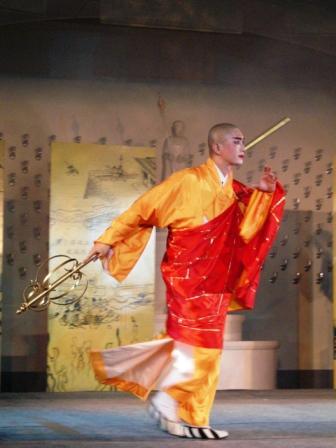
Mu Lian performed by Siong Leng in Singapore
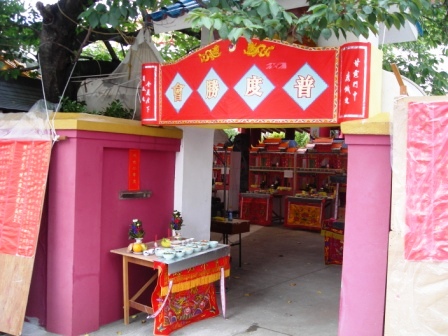
Zhong Yuan Jie at the Guan Gong temple in Kobe, Japan
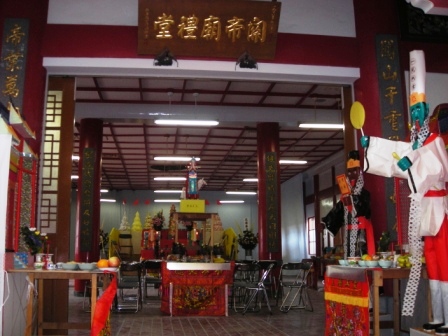
Prayer hall in the Guan Gong Temple, Kobe Japan

Zhong Yuan Jie prayers at the
Guan Gong Temple, Kobe Japan

Burning of offerings in Taipei

Hungry Ghost prayer at the Tainan Grant Matsu Temple
|









